W 2010 roku napisaliśmy nasz popularny przewodnik krok po kroku na temat jak skonfigurować FeedBurner. Nieco ponad rok temu postanowiliśmy przestać używać FeedBurner dla wszystkich naszych stron. Od tego czasu otrzymaliśmy setki pytań dotyczących różnych błędów, problemów itp. związanych z FeedBurner. W tym artykule omówimy, dlaczego należy unikać korzystania z FeedBurner. Jeśli już go używasz, pokażemy Ci, dlaczego musisz przestać używać FeedBurner i jak możesz przejść na niezawodne alternatywy dla FeedBurner.
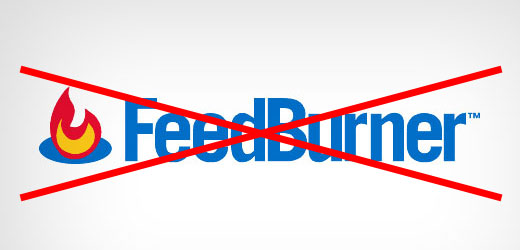
FeedBurner to usługa zarządzania kanałami RSS firmy Google, na której wielu blogerów polegało kilka lat temu (Co to jest RSS?). Chociaż Google jeszcze go nie zamknęło, od jakiegoś czasu krążą pogłoski, że Google zamierza je zamknąć.
FeedBurner nie widział żadnych funkcji ani aktualizacji od bardzo dawna. API FeedBurner zostało wyłączone. Wycofali również funkcję Adsense for Feeds. Wszystko to wydarzyło się w 2012 roku.
Dlaczego więc piszemy o tym teraz – dwa lata później?
Cóż, ponieważ nadal otrzymujemy e-maile od użytkowników dotyczące FeedBurner. W ciągu ostatnich 30 dni nasz stary przewodnik konfiguracji FeedBurner otrzymał ponad 3500 unikalnych odwiedzin z ruchu z wyszukiwarek. Ponieważ FeedBurner nie ma wsparcia, otrzymaliśmy dziesiątki zgłoszeń błędów i próśb o wsparcie.
Chcemy skierować wszystkich zainteresowanych użytkowników do bardziej aktualnego artykułu.
Alternatywy FeedBurner
Oprócz analizy subskrybentów i możliwości monetyzacji za pomocą Adsense, FeedBurner oferował dwie główne funkcje, które uwielbiali blogerzy.
- FeedBurner dawał blogerom lepszy sposób na wyświetlanie ich kanału RSS, oferując jednocześnie opcje udostępniania użytkownikom.
- FeedBurner oferował darmowy i łatwy sposób na subskrypcję Twojego bloga przez e-mail.
Przyjrzyjmy się, jak zastąpiliśmy FeedBurner lepszymi alternatywami.
W WPBeginner używamy domyślnych kanałów WordPress i zarządzamy nimi samodzielnie. Korzystanie z domyślnych kanałów WordPress daje Ci kontrolę nad kanałem. Zalecamy naszym użytkownikom poleganie na domyślnej funkcjonalności WordPress i samodzielne zarządzanie kanałami. Oto dlaczego:
Atrakcyjny wygląd kanału z opcjami udostępniania
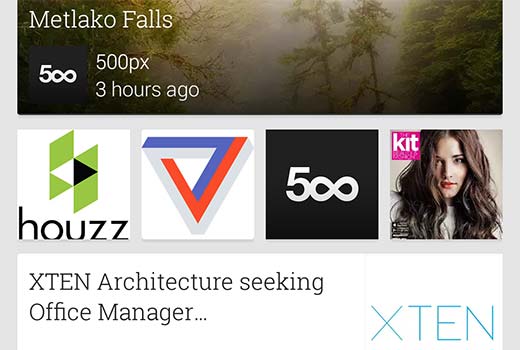
Musisz zrozumieć, że ludzie nie odwiedzają adresu URL Twojego kanału, aby czytać Twoje treści. Zamiast tego większość ludzi korzysta z czytników kanałów, takich jak Feedly, Flipbook, Google Newsstand itp. Te czytniki kanałów już wykonują większość zadań, które FeedBurner wykonywał jakieś pięć lat temu.
Jeśli używasz FeedBurner do lepszego wyświetlania kanałów i udostępniania w mediach społecznościowych, nie musisz już tego robić. Możesz jednak z pewnością edukować swoich użytkowników, jak subskrybować Twoją witrynę.
Subskrypcja bloga przez e-mail
Wielu użytkowników nadal woli otrzymywać aktualizacje bloga pocztą e-mail, dlatego kluczowe jest, aby zastąpić tę funkcjonalność.
Chociaż wtyczka JetPack oferuje najbliższą alternatywę dla funkcji subskrypcji e-mailowej FeedBurner, zdecydowanie odradzamy naszym użytkownikom jej używania.
Dlaczego? Ponieważ podobnie jak FeedBurner, nie możesz wysyłać ekskluzywnych aktualizacji do swoich subskrybentów. Jedynym sposobem na aktualizację subskrybentów jest publikowanie publicznego wpisu.
Skoro podjąłeś decyzję, aby robić rzeczy we WŁAŚCIWY sposób, zalecamy zacząć budować listę e-mailową.
Profesjonalne usługi e-mail marketingu takie jak MailChimp, AWeber itp. pozwalają na oferowanie subskrypcji bloga przez e-mail, jednocześnie dając Ci pełną moc rozbudowanej platformy e-mail marketingu. Otrzymujesz lepsze analizy, takie jak liczba użytkowników, którzy otworzyli Twój e-mail, ilu kliknęło w niego itp.
Otrzymujesz również wyższy wskaźnik dostarczania, co oznacza, że więcej Twoich użytkowników otrzyma Twoje aktualizacje. Na koniec, ale nie mniej ważne, zyskujesz elastyczność i opcje.
Na przykład możesz zaoferować wiele opcji subskrypcji (codzienne aktualizacje, cotygodniowe aktualizacje itp.) – zobacz nasz przewodnik po tworzeniu codziennego i cotygodniowego biuletynu.
Używamy MailChimp dla naszej strony i jest BEZPŁATNY dla maksymalnie 2000 subskrybentów.
Teraz, gdy omówiliśmy alternatywy, przyjrzyjmy się, jak możesz odejść od FeedBurner.
Odchodzimy od FeedBurner
Jeśli korzystałeś z usługi subskrypcji e-mailowej FeedBurner, pierwszą rzeczą, którą musisz zrobić, to wyeksportować swoich subskrybentów e-mailowych. Po prostu zaloguj się na swoje konto FeedBurner i kliknij swój kanał. Następnie kliknij link „Zobacz więcej o swoich subskrybentach”.
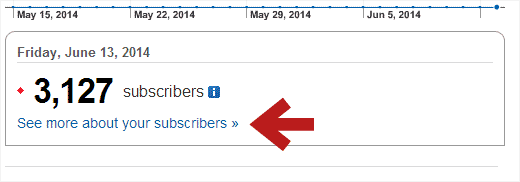
Na następnym ekranie przewiń w dół do sekcji Usługi subskrypcji e-mail i kliknij FeedBurner Email Subscriptions. Spowoduje to rozwinięcie sekcji i zobaczysz link do zarządzania listą subskrybentów e-mail. Kliknij link, aby zobaczyć swoich subskrybentów e-mail.
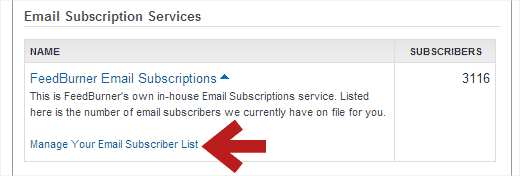
FeedBurner wyświetli teraz listę Twoich subskrybentów e-mail. Powyżej listy zobaczysz link Export CSV. Po prostu kliknij go, a pobierze Twoją listę w formacie CSV. Następnie możesz zaimportować ten plik do wybranej usługi marketingu e-mailowego, takiej jak MailChimp, AWeber itp.
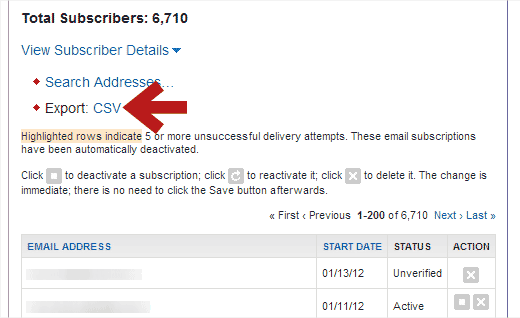
Ponieważ używamy MailChimp dla naszej strony, pokażemy Ci, jak działa funkcja importu w MailChimp. Większość innych dostawców ma podobny proces.
Pierwszą rzeczą, którą musisz zrobić, to zalogować się do panelu MailChimp i utworzyć nową listę w MailChimp.
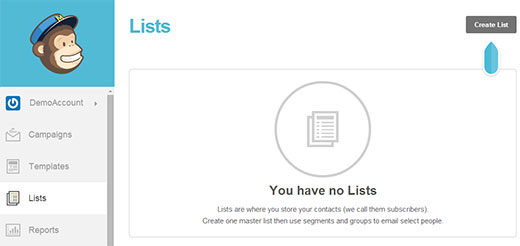
Po utworzeniu nowej listy możesz zaimportować subskrybentów e-mail za pomocą pliku CSV, który pobrałeś z FeedBurner. Zacznij od kliknięcia menu Listy na pulpicie MailChimp i wybierz swoją nowo utworzoną listę. Spowoduje to przejście do strony zarządzania listą. Tam musisz kliknąć Subskrybenci » Importuj subskrybentów.
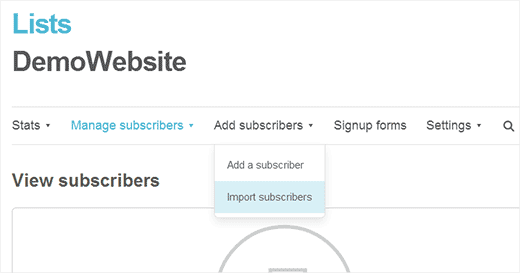
Na następnym ekranie kliknij opcję „Importuj z pliku CSV lub TXT”, a następnie zaimportuj plik CSV pobrany z FeedBurner.
Po zaimportowaniu listy będziesz musiał utworzyć kampanię RSS do e-mail.
Różne usługi marketingowe e-mail będą miały różne nazwy dla tej funkcjonalności. W MailChimp nazywają to kampanią RSS do e-mail. W AWeber nazywają to Transmisjami. Po prostu wyszukaj w Google „nazwa Twojej usługi marketingowej e-mail i RSS bloga”, a znajdziesz samouczek dla niej.
Po skonfigurowaniu wszystkiego możesz wyłączyć subskrypcje e-mail w FeedBurner, aby Twoi użytkownicy nie otrzymywali dwóch e-maili. Możesz to zrobić, przechodząc do zakładki Publicize (Promuj) w FeedBurner i klikając link Email Subscriptions (Subskrypcje e-mail) w lewej kolumnie.
Pamiętaj, że podczas przenoszenia subskrybentów e-mail do nowej usługi e-mail, możesz stracić niektórych subskrybentów, ale są to nieaktywni subskrybenci, których prawdopodobnie i tak nie chcesz.
Przekieruj subskrybentów FeedBurner z powrotem do kanału WordPress
Powszechne było, że blogerzy przekierowywali swoje adresy URL kanałów WordPress do swoich stron FeedBurner. Niektórzy robili to za pomocą wtyczki takiej jak FD FeedBurner, podczas gdy inni korzystali z wbudowanej funkcjonalności swojego motywu, a bardziej zaawansowani używali fragmentu kodu.
Jeśli używasz którejkolwiek z powyższych metod do przekierowania domyślnego kanału WordPress, natychmiast przestań z nich korzystać.
Najlepszym sposobem, aby sprawdzić, czy przekierowujesz swój kanał, jest odwiedzenie adresu URL swojego kanału RSS:
http://www.yoursite.com/feed/
Jeśli przekierowuje to do FeedBurner, nie naprawiłeś tego.
Następnie napisz post na blogu i poproś subskrybentów o zaktualizowanie adresu URL i ewentualnie poinformuj ich, jak mogą subskrybować Twoją stronę za pomocą innych czytników.
Ważne: NIE USUWAJ swojego kanału FeedBurner. Istnieją strony, które powiedzą Ci, aby USUŃ swoje kanały FeedBurner, co rzekomo przekieruje Twoich subskrybentów, ale tak nie jest. To okropny pomysł i stracisz swoich subskrybentów. Dlaczego?
Ponieważ po usunięciu kanału, FeedBurner doda nowy wpis informujący czytelników, że kanał został przeniesiony. Nie aktualizuje to automatycznie adresu URL kanału w czytnikach kanałów użytkowników. Jeśli użytkownik nie podejmie żadnych działań w ciągu 15 dni, stracisz tego subskrybenta na zawsze. Ponadto po 30 dniach konkurent może przejąć Twój adres URL FeedBurner, a wszyscy użytkownicy, którzy nie zaktualizowali swoich kanałów, zaczną otrzymywać jego aktualizacje.
Jeszcze raz, NIE USUWAJ swoich kanałów FeedBurner.
Po prostu napisz post na blogu, aby powiadomić czytelników o konieczności zaktualizowania ich adresów URL. Edukuj ich, dostarczając zasoby na temat tego, jak mogą to zrobić.
Po tym po prostu pozwól, aby kanał FeedBurner powoli umarł.
W ten sposób ci, którzy nie zaktualizują adresu URL swojego kanału w swoim czytniku RSS, nadal będą otrzymywać nowe treści, ale wszyscy Twoi nowi czytelnicy będą subskrybować we właściwy sposób.
Twórz formularze subskrypcji, strony subskrypcji i więcej
Teraz, gdy utworzyłeś swoją listę e-mailową i powróciłeś do domyślnego adresu URL kanału WordPress, powinieneś wprowadzić odpowiednie aktualizacje na swojej stronie, takie jak usunięcie wszystkich wzmianek o adresie URL FeedBurner, zaktualizowanie formularzy zapisu na e-mail itp.
Do dodawania formularzy zapisu do Twojej witryny polecamy użycie OptinMonster. Pozwala on na tworzenie skutecznych formularzy zapisu, takich jak formularze zapisu w pasku bocznym, formularze po wpisie, pływający pasek stopki, wyskakujące okienka, okienka modalne itp.
Używamy go na naszej stronie i pomógł nam zwiększyć naszą listę e-mail o 600%.
Następnie prawdopodobnie chcesz utworzyć stronę subskrypcji, która pokazuje czytelnikom, jak mogą subskrybować Twoją witrynę.
Ponieważ używasz domyślnego kanału WordPress, masz dużą elastyczność i opcje dostosowywania.
Możesz dodać miniatury do swoich kanałów RSS, dodać inne niestandardowe treści do kanałów RSS lub całkowicie stworzyć niestandardowe kanały RSS.
Inną przydatną funkcją wbudowaną w WordPress jest możliwość tworzenia kanałów RSS dla poszczególnych kategorii. Możesz pozwolić swoim użytkownikom subskrybować poszczególne kategorie za pomocą kanału RSS kategorii. Przeczytaj nasz artykuł na temat jak pozwolić użytkownikom subskrybować kategorie w WordPress.
Mamy nadzieję, że ten przewodnik pomógł Ci znaleźć sposób na poradzenie sobie z upadkiem FeedBurner i przejście do lepszych opcji. Zdecydowanie zalecamy zaprzestanie korzystania z FeedBurner.
Jeśli podobał Ci się ten artykuł, zasubskrybuj nasz Kanał YouTube, aby uzyskać więcej samouczków wideo dotyczących WordPress. Możesz również dołączyć do nas na Twitterze i Google+.

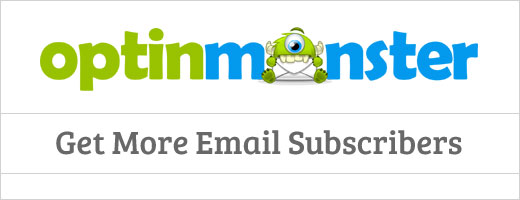




Andrew Blackman
Bardzo przydatne, dzięki! Zarejestrowałem się w Feedburner jeszcze przed erą Google i trzymałem się tego z lenistwa przez te wszystkie lata. Wreszcie zabieram się za odejście od niego, a ten przewodnik jest dokładnie tym, czego potrzebowałem.
Ryan
Feedburner pozwala teraz na trwałe przekierowanie przy usuwaniu kanału. Nie ma już 30-dniowego okresu oczekiwania.
Ankit Dhadwal
Widziałem inne platformy RSS, takie jak Alltop. Czy możesz opublikować tutorial na ten temat? Mam problem z ustaleniem, jak z tego korzystać. Inni również mogą uznać to za przydatne.
Dziękuję
Wsparcie WPBeginner
Hej Ankit,
Zapoznaj się z naszym przewodnikiem Co to jest RSS i jak używać RSS w WordPressie?
Admin
Leslie Myricks
Witaj,
Niedawno subskrybowałem Feedburner. Przeszedłem do innych usług, aby wprowadzić informacje o moim blogu. Za każdym razem, gdy wprowadzałem je do Feedage, otrzymywałem komunikat, że to nie działa. Mówiło, abym wziął adres URL i wprowadził go do wyszukiwarki. Jeśli mój kanał się pojawił (co się stało), to miało mi dać znać, że mam poprawny adres URL. Jednak za każdym razem, gdy próbuję go przesłać do innych usług, otrzymuję ten sam komunikat. Nie rozumiem. Może możesz doradzić. Dzięki!
Coach Maria
Well, I’ve decided to use feedburner for what it’s worth I do have an ezine, too. I tried Jetpack’s version of subscribing and actually liked it since people get new posts delivered without me having to do anything.
I do have an ezine, too. I tried Jetpack’s version of subscribing and actually liked it since people get new posts delivered without me having to do anything.
Powiedziałbym, że JEŚLI Twoja idealna publiczność lubi kanały RSS (tak jak moja najwyraźniej), to ich używaj. Jeśli nie, to nie.
Anne
Głównym problemem, jaki widzę, jest trudność w przejściu z usługi bezpłatnej na płatną. Strona za stroną mówi o MailChimp i innych usługach jako darmowych, ale tylko wtedy, gdy masz niewielką liczbę subskrybentów. Jednocześnie te blogi mówią nam, jak powinniśmy STALE rozwijać naszych subskrybentów. Co oznacza, że szybko przekroczymy „darmową” usługę.
Co wtedy będzie kosztować około 40 USD lub więcej miesięcznie.
Czy mógłbyś napisać artykuł o całkowicie DARMOWYCH programach RSS do e-mail, takich jak Feedburner? A może istnieje płatna usługa, która nie kosztuje fortuny, jeśli masz ponad 2000 subskrybentów?
Dzięki!
Don
99% kanałów RSS nie jest czytanych, istnieją dzisiaj tylko dla celów SEO. Używasz feedburner, ponieważ Google jest jego właścicielem. Koniec kropka.
Leslie
feedburner zmienił mój oryginalny kanał na
Wiem, że mówiłeś, żeby tego nie usuwać, ale niestety nie mam tu subskrybentów. Używam jednak powyższego RSS do mojego konta Mailchimp. Czy to łatwo naprawić? Czy mogę usunąć powyższy kanał i wrócić do używania mojego oryginalnego z WordPressa?
Wsparcie WPBeginner
Hej Leslie,
Jeśli używałeś swojego kanału FeedBurner do wysyłania postów e-mailem do swojej listy e-mailowej MailChimp, możesz edytować integrację i zastąpić kanał FeedBurner swoim kanałem RSS WordPress.
Admin
malcolm
Nie chcę Feedburner ani jego alternatyw, ponieważ nie mam dla nich zastosowania, ale ciągle otrzymuję wiadomość od Feedburner z jakimś linkiem do hazardu. Jak mogę zatrzymać wszystkie linki Feedburner? Nigdy się do nich nie subskrybowałem, więc chciałbym je zatrzymać, proszę o pomoc.
P.S. Nie mam u nich konta.
Wsparcie WPBeginner
Cześć Malcolm,
Jeśli widzisz to w sekcji komentarzy swojej witryny WordPress, to są to tzw. trackbacki. Zobacz nasz przewodnik, jak powstrzymać spam typu trackback w WordPress.
Jeśli otrzymujesz je w swoim e-mailu, zgłoś je jako spam, a filtry Twojego e-maila zaczną wysyłać te wiadomości do spamu.
Admin
toni
Feed WordPress wymaga od użytkowników założenia konta WordPress.
To zbyt duży wysiłek. Większość tego nie zrobi. Nawet w przypadku Feedburner konieczność wpisania adresu e-mail, kodu i potwierdzenia e-mail to dla większości za dużo. Czy jest opcja z Facebookiem?
Thomas
Nie wiem, czy te wątki komentarzy są nadal monitorowane, ale zaczynałem od Feedburner na samym początku i w końcu odchodzę. Problem polega na tym, że używam go do śledzenia pobrań podcastów. Jaka jest dobra alternatywa?
David P
Proszę o pomoc. Jestem nowy w WordPress i w całym tym RSS i wszystko to jest dla mnie bardzo mylące. Czy ktoś może mi pomóc to zrozumieć. Może artykuł, który upraszcza dla początkujących użytkowników WordPress wszystko o RSS, od tego, czym jest, po to, jak go używać i jak go skonfigurować w WordPress, kanał RSS, subskrypcje kanału RSS i całą tę otoczkę... byłby bardzo doceniony.
Obecnie konfiguruję nową stronę WordPress, która zastąpi inną działającą stronę WordPress. Ale zanim zacznę konfigurować subskrypcję RSS, nowy kanał RSS lub cokolwiek związanego z RSS dla nowej strony, wyobrażam sobie, że muszę ustalić, czy obecna strona już to wszystko ma, być może powiązane konto Feedburner lub jakichkolwiek subskrybentów. Jak to zrobić? Motyw WP, którego używam, ma widżet subskrypcji biuletynu, który zawiera w swoich ustawieniach opcję wprowadzenia adresu URI Feedburner. Jeśli nie powinienem przejmować się Feedburner, to może nie powinienem przejmować się tym widżetem. Może powinienem po prostu zastąpić go widżetem z Mailchimp, a w przypadku, gdy obecni subskrybenci starego kanału RSS zostaną utraceni, to wtedy się tym zajmę, ale najpierw… jak zacząć?
Wsparcie WPBeginner
Zapoznaj się z naszym przewodnikiem dla początkujących: Czym jest RSS? Jak używać RSS w WordPress?
Admin
monique
Cześć Syed i zespół, Wasz artykuł dotyczy głównie odejścia od Feedburner. Czy możecie zrobić artykuł o tym, jak skonfigurować kanał RSS, czym on jest i jak działa z Aweber itp. Nadal nie rozumiem, jak to się różni od subskrypcji e-mail, jeśli RSS i tak wysyła Ci e-mail. Dopiero zaczynam i nie potrzebuję informacji o odejściu od Feedburner, a to pozostawiło mnie bardzo zdezorientowanym, co mam teraz zrobić. dziękuję!
Wsparcie WPBeginner
Cześć monique,
RSS it self does not send email to subscribers when you publish a new article. For that you will need an email service. The email service provider then uses your WordPress RSS feed to fetch articles and automatically email them to your subscribers. Hope this helped, let us know if you have more questions.
Admin
Erin
Czuję, że czegoś tu brakuje. Odszedłem od Feedburnera LAT LAT LAT, kiedy po raz pierwszy ogłosili, że nie będą już aktualizować API. Przeszedłem na Feedblitz i uruchamiam ten kanał przez Mailchimp w kampanii RSS.
Problem, z którym się borykam i przez który trafiłem na ten post, polega na tym, że Feedblitz wstawia obrazek o rozmiarze 1×1 piksela do kanału, a Mailchimp konwertuje go na obrazek o rozmiarze 600×600 pikseli, który przesuwa zawartość mojego kanału w dół strony. SZUKAM więc alternatyw. Ale czy przepuszczanie kanału WordPress przez usługę RSS jest jeszcze w ogóle czymś aktualnym? Czy mogę pominąć całą usługę RSS i przepuścić domenę domain.com/feed bezpośrednio przez kampanię RSS Mailchimpa do automatycznych wysyłek?
Z góry dziękuję!
Wsparcie WPBeginner
Tak, możesz użyć domyślnego kanału RSS WordPress za pośrednictwem kampanii MailChimp RSS do e-mail.
Admin
Ron
Jedna rzecz, której nienawidzę w Mailchimp, to to, że wyświetla mój adres fizyczny i e-mail w końcowym komunikacie potwierdzającym dla subskrybentów. Wspomniałem o tym obsłudze klienta, ale jest to część polityki antyspamowej. Adres powinien być utrzymywany w tajemnicy z różnych powodów.
Nie podoba mi się również captcha... nie ma możliwości wyłączenia tej funkcji. To uciążliwe i może zniechęcić ludzi do zapisywania się.
Vince
Całkowicie się zgadzam. Chcę przejść z Mailchimpa, zanim moja lista zacznie rosnąć.
Candice
Cześć. Jestem 3 tygodnie po rozpoczęciu budowy mojego pierwszego bloga na WP, nie myślałem zbytnio o pozyskiwaniu list e-mailowych, w przeciwieństwie do umieszczania treści… Pobralem wtyczkę o nazwie Ultimate Social Media Plus… Zawiera ona również monit, który prosi czytelników o subskrypcję nowych postów… Czym to się różni od MailChimp? WP ma również widżet, który pozwala mi umieścić pole subskrypcji na stronach… znowu, czym to się różni od tych usług e-mail, o których mówicie? Mam bardzo małe doświadczenie technologiczne, mam nadzieję, że moje pytanie nie jest zbyt głupie. Z góry dziękuję!!!
Wsparcie WPBeginner
Zapoznaj się z naszym przewodnikiem na temat dlaczego powinieneś zacząć budować swoją listę e-mailową od razu.
Admin
Dan Stafford
Zastanawiam się, jak zastąpić wsparcie Feedburner dla list podcastów i usługi pingshot.
ikomrad
To samo tutaj. Większość moich wiadomości dostaję z Feedly i chciałbym się tam zarejestrować, aby jeśli ktoś wyszuka mój blog w Feedly, mógł go znaleźć i zasubskrybować mój kanał RSS.
Czy jest na to jakiś sposób?
Wsparcie WPBeginner
Witaj ikomrad, zapoznaj się z naszym przewodnikiem jak zoptymalizować swój kanał RSS WordPress. Zawiera on wskazówki dotyczące optymalizacji witryny WordPress pod kątem Feedly, dzięki czemu Twój blog będzie bardziej widoczny w Feedly.
Admin
Henning Uhle
Świetny post. Dziękuję. Ale jedna rzecz jest dziwna.
Mailchimp działa jak marzenie. Używam kampanii opartych na RSS, które wysyłają e-maile do moich subskrybentów raz dziennie o określonej godzinie. Jeśli RSS WordPress nie jest dostępny w tym czasie, żaden e-mail nie jest wysyłany. A ludzie z Mailchimp poinformowali mnie, abym używał Feedburner lub innych usług buforowania RSS, aby zapobiec temu problemowi.
A ponieważ Feedburner nie zginął, używam go zgodnie z zaleceniami Mailchimp. Teraz myślę o przejściu na Google Newsstand, aby mieć usługę buforowania RSS, która jest bardziej przyszłościowa. Ale nie jestem pewien, czy Mailchimp z nią współpracuje. Ale spróbuję.
Pozdrawiam, Henning
shan
Obecnie nie ma alternatywy dla Feedburner. Ponieważ jest to darmowa usługa. A e-maile nigdy nie trafiają do folderu spamu. Jeśli masz dużo pieniędzy do wydania na subskrypcję e-mail, zamknij usługę Feedburner i znajdź alternatywę.
Tak, jasne
Oczywiście. FB jest wysyłany przez Google, więc nadal jest to najlepszy sposób dostarczania poczty e-mail.
Alana
Dziękuję za wszystkie wskazówki! Właśnie przeszedłem na MailChimp i to bardzo pomogło!
andrea
Miesiąc temu przeszedłem na Aweber. Kiedy importowaliśmy moich subskrybentów do Aweber, nie było imion, tylko adresy e-mail. Czy Feedburner w ogóle przechwytuje imię? Jeśli nie, to yikes! Nie jestem pewien, jak mogę wrócić i przechwycić imiona 600 subskrybentów!
Wsparcie WPBeginner
Możesz skontaktować się z pomocą techniczną Aweber. Być może będziesz musiał wymagać od wszystkich użytkowników ponownego potwierdzenia subskrypcji.
Admin
Ganesh
Miły post, dzięki za udostępnienie informacji o Feedburner.
Kady
Bardzo dziękuję za ten wpis na blogu! Był bardzo pomocny, gdy przenosiłem wszystkie moje posty e-mail z Feedburner i Jetpack do Mailchimp!
Nostromov
Ugh, nie wiem, czy wy jesteście nieświadomi – czy co?! FeedBurner nie żyje i odszedł… Jego domeny, feedburner.com/ i feedburner.org/ są zaparkowane; poza Google, już nie istnieje!..
Może aktualizacja artykułu, albo coś w tym stylu, byłaby dobra?? :))
Josh
Te domeny zostały zdezaktywowane około 5-6 lat temu po tym, jak Google przejęło usługę Feedburner. Feedburner można teraz znaleźć pod adresem feedburner.google.com.
Jennifer Harry
Używam wtyczki do newsletterów do wysyłania biuletynów, ale mam problem ze zrozumieniem, co zrobić z regularnym wysyłaniem biuletynów. Przypuszczam, że będę musiał się na tym skupić i to zrobić, ale jest to trudne, gdy masz milion innych zadań do wykonania!
Lance McGrew
Subskrypcje e-mail stają się lub stały się staromodne. Natychmiastowe powiadomienia push to nowa droga. Lepsze natychmiastowe zadowolenie, brak problemów z trafianiem Twoich kanałów do folderów ze spamem. Zwróć uwagę subskrybentów, nawet gdy ich aplikacja pocztowa nie jest otwarta. Problem polega na tym, że nie znajduję jasnego sposobu na integrację natychmiastowych powiadomień push z postami WordPress. 30-minutowe powiadomienia push Feedburner są niewystarczające. Boxcar2 wymaga od użytkownika ręcznego wpisania niestandardowego adresu URL. Brak oczywistego sposobu, aby pozwolić subskrybentom na niestandardowy wybór, które kanały lub powiadomienia chcą otrzymywać na swoje urządzenia mobilne.
Vince
Nie jestem pewien, czy się zgadzam. Modne rzeczy przychodzą i odchodzą, ale lista e-mailowa nadal króluje w iM.
Kimm Boes
Witam, szukam pomocy w sprawie problemu z kanałem. Niedawno przejąłem bloga, mojego drugiego, i zainstalowałem nowy motyw. Wyeksportowałem również subskrybentów Feedburner do Mailchimp i skonfigurowałem kampanię RSS w Mailchimp, aby wysyłać moje nowe posty do moich subskrybentów każdego ranka. Problem polega na tym, że mój kanał się nie aktualizuje, więc Mailchimp nie otrzymuje powiadomienia o opublikowaniu nowych treści i nie wysyła e-maila. O ile rozumiem, mój kanał nadal pochodzi z Feedburner, ale kiedy loguję się do tego konta, pokazuje stare treści, sprzed przejęcia bloga. Jeśli kliknę „resync”, zaktualizuje się, ale wraca do poprzedniego stanu. Czy możesz pomóc?
Daniel Boswell
Ten wątek komentarzy wydaje się trochę stary, ale dla tych, którzy pytają o MailChimp, funkcja RSS do e-mail działa w wersji darmowej. Istnieje również kilka darmowych szablonów e-mail RSS do wyboru, które mają wszystko już skonfigurowane. Podczas procesu konfiguracji RSS do e-mail, jeden z kroków pozwala wybrać szablon. Po prostu dodaj swoje logo lub swoje imię w tekście na banerze, dokonaj wszelkich zmian kolorów, które chcesz, i dostosuj czcionkę, jeśli nie podoba Ci się to, co tam jest, a powinieneś być gotowy.
Chaz DeSimone
Daniel, dziękuję za publikację, mimo że „ten wątek wydaje się stary”. Muszę zainstalować RSS i Mailchimp, a Twoje dwa punkty dotyczące działania RSS do Email w darmowej wersji oraz tego, że mogę wybrać szablon i dokonać prostych dostosowań, są dla mnie decydujące. Dziękuję. (Strona, którą teraz tworzę, dotyczy niemych filmów sprzed 100 lat – nawlekanie filmu na Powergraph z 1906 roku to „stary wątek”!)
Jim
Polecasz używanie domyślnego kanału RSS WP, ale jest on zepsuty i nie generuje działających plików xml. (WP 4.2.2)
Eli
Cześć,
Twój blog jest bardzo dobry!
Małe pytanie, używam WordPressa do tworzenia blogów i mam program RSS od WP. Kiedy klikam w ikonę RSS na mojej stronie internetowej, w przeglądarce Internet Explorer kanał RSS wyświetla się dobrze, ale w Chrome nie. Dlaczego? Jak mogę to naprawić, aby wyświetlał się również w Chrome?
Czekam z niecierpliwością i dziękuję!
Eli Kassel.
Lucky Bhumkar
Najcenniejszy post. Dziękuję za ostrzeżenie mnie, zanim wpadnę w pułapkę Feedburner.
Sonia
Niedawno przeszedłem na MailChimp i teraz chcę całkowicie przestać używać FeedBurner, ale obawiam się, że nie mam pojęcia, jak to zrobić...
Teraz, gdy FeedBurner oferuje opcję trwałego przekierowania, czy usunięcie kanału byłoby akceptowalnym sposobem przekierowania kanału z powrotem do oryginalnego źródła, tj. WordPress, czy nadal potrzebowałbym dodatkowych kroków, nawet jeśli bym to zrobił? Minęły lata, odkąd zacząłem używać FeedBurner i teraz nie mam pojęcia, jak to cofnąć. Wiem na pewno, że nie używałem wtyczki do przekierowania i nie modyfikowałbym pliku header.php, ponieważ nie mam pojęcia, jak to zrobić...
Nie wiem, jak odzyskać mój kanał i pozbyć się FeedBurner… Pomocy!
suryatejaaaa
ale problem z mailchimp polega na tym, że kiedy wysyłamy e-maile przez mailchimp, trafią one bezpośrednio do folderu promocje i nikt ich nie zauważy.. Jeśli masz jakieś sugestie, lepiej mi powiedz..
Tri Wahyudi
For me Feedburner remain useful for capturing traffic to my blog
Lukas Brandt
A co z Feedpress.it?
Nancy Ward
Mam 50 subskrybentów e-mail, którzy są na liście Feedburner i otrzymują aktualizacje e-mail. Mam również 740 zarejestrowanych użytkowników, którzy nie są na liście Feedburner jako subskrybenci i dlatego nie otrzymują e-maili. Jakie są moje opcje przeniesienia się z Feedburner do innej aplikacji e-mail, aby uwzględnić zarejestrowanych użytkowników?
Quinn W
Bardzo dziękuję za to! Mam jedno pytanie – wspomniałeś o możliwości stworzenia kampanii dla kategorii lub tagu bloga w Mailchimp RSS do e-mail. Próbowałem obu, ale Mailchimp za każdym razem wraca do mojego głównego kanału bloga. Czy masz jakieś spostrzeżenia, dlaczego tak się dzieje? ~Quinn
Mary A. Axford
Mój blog używa Feedburner, aby umożliwić ludziom subskrypcję przez e-mail. Bardzo wcześnie (blog zaczął działać w połowie 2012 roku) mogłem się zalogować. Jednak zacząłem otrzymywać komunikat o konieczności zalogowania się w celu odebrania mojego konta Feedburner, a identyfikator i hasło nie działały. Jedynym sposobem, jaki znałem, aby spróbować uzyskać pomoc, było opublikowanie postu na forum Google, a do tej pory Google zignorowało moje i wielu innych ludzi prośby o pomoc w tej sprawie. Jakieś pomysły? Nie chcę zmuszać moich subskrybentów e-mail do subskrypcji za pomocą czegoś innego. Dzięki!
Zespół WPBeginner
MailChimp ma funkcję zwaną RSS do e-mail.
Kennis Wong
MailChimp nie jest dokładnie alternatywą dla subskrypcji e-mailowej publikacji na blogu, prawda? Z tego, co rozumiem, będziesz musiał ręcznie utworzyć e-mail do wysłania do swoich subskrybentów, jeśli korzystasz z MailChimp, podczas gdy w Wordpress Jetpack Twoi subskrybenci automatycznie otrzymują powiadomienie e-mail o każdym nowym poście. Widzę, że te dwie usługi uzupełniają się nawzajem (chociaż może to być mylące dla czytelników, jeśli masz dwa oddzielne formularze zapisu). Popraw mnie, jeśli się mylę co do MailChimp.
Anya
Płatna wersja Mailchimpa może być zaprogramowana do pobierania kanału RSS z bloga i automatycznego tworzenia e-maili. Mogą być one również stylizowane i opatrzone marką. Jest to dość proste i wymaga testowania, ale jest możliwe.
Doreen
Wierzę, że nieumyślnie zapisałem się na dwa konta Feedburner, ale znajduję tylko jedno. Czy możesz mi powiedzieć, jak znaleźć drugie konto, abym mógł porzucić Feedburner i przenieść moich subskrybentów?
Zespół WPBeginner
Najlepszym sposobem, aby to rozgryźć, jest cofnięcie się po krokach, które podjąłeś podczas wdrażania FeedBurner i po prostu ich cofnięcie.
Zespół WPBeginner
Przejdź do strony Wtyczki i sprawdź, czy nie ma zainstalowanej wtyczki, która w nazwie lub opisie zawiera feedburner. Jeśli znajdziesz taką wtyczkę, dezaktywuj ją.
Sprawdź również plik header.php swojego motywu, poszukaj linii zawierającej adres URL Twojego kanału Feedburner.
Na koniec sprawdź plik functions.php swojego motywu. Poszukaj bloku kodu zawierającego adres URL Twojego kanału Feedburner.
Jacqueline
Jedyną wtyczką, którą widzę, która odnosi się do Feedburner, jest WP Subscriber Form. Obecnie jest ona dezaktywowana. Będę szczery i powiem, że nie mam pojęcia, jak znaleźć moje pliki .php, a tym bardziej jak je edytować. Jestem kompletnym nowicjuszem w tych sprawach i doceniam każdą pomoc.
Jacqueline
Znalazłem ten post dokładnie dzień po wdrożeniu Feedburner. Ugh! Jestem bardzo nowy w blogowaniu i sprawach technicznych, tj. edycji plików, FTP, CSS i reszty. Czy możesz mi pomóc wszystko naprawić? Nie mogę znaleźć sposobu, aby przekierować moje kanały z powrotem do stanu sprzed dwóch dni. Byłbym wdzięczny za jakąkolwiek pomoc!
Zespół WPBeginner
Rozumiem problem z podawaniem Twojego prawdziwego adresu. Ale musisz go również podać podczas rejestracji nazwy domeny.
Chyba że kupiłeś prywatną rejestrację lub WhoIsGuard, wtedy każdy może poznać Twój adres.
Widzieliśmy wielu blogerów, którzy po prostu podawali adres swojego domu dla swojego MailChimp Email.
Chciałbym móc dać ci lepsze rozwiązanie, ale to wszystko. Możesz użyć JetPack, ale znowu napotkasz te same ograniczenia. Z FeedBurner byłeś zdany na łaskę Google, a teraz będziesz zdany na łaskę Automattic.
Ciągle głodny
Dziękuję za artykuł. Dokładnie tego szukałem w internecie.
Jestem nowym blogerem i w tej chwili nie mam nic do sprzedania na mojej stronie (brak dochodów). Chociaż rozumiem, że MailChimp jest darmowy, będę musiał podać fizyczny adres do wysyłki, aby przestrzegać przepisów anty-spamowych. Oznacza to, że będę musiał wynająć skrytkę pocztową, co jest kosztem, którego teraz nie chcę ponosić. Inne wtyczki/usługi do subskrypcji e-mail nie wymagają tych informacji, ale zdaję sobie sprawę, że mają swoje własne ograniczenia.
Jakieś rady, jak postępować?
Heather Solos
Przejrzystość, pracuję dla FeedBlitz.
Natywne kanały RSS działają dobrze w większości nowych czytników, jednak usługi takie jak nasza oferują dodatkowe funkcje, takie jak możliwość mierzenia odbiorców kanału RSS i dodawania reklam do kanału RSS, tworząc dodatkowe źródło pasywnego dochodu.
Ułatwiamy również dodawanie własnych statycznych reklam do kanałów RSS.
Oferujemy również wsparcie na żywo w godzinach pracy.
Chętnie odpowiem na wszelkie pytania dotyczące usługi.
tylko przechodzę
Feed Demon. Więcej nie trzeba mówić
Zespół WPBeginner
Nie musisz dodawać żadnego kodu do swoich kanałów RSS. Domyślne kanały WordPress działają od razu. Jednak jeśli czujesz, że musisz coś dodać do swoich kanałów RSS, istnieją wtyczki, które na to pozwolą. Na przykład WordPress SEO pozwoli Ci dodać treść, która pojawi się poniżej każdego posta w Twoim kanale RSS.
Jak wspomnieliśmy w artykule, nie będziesz usuwać swojego kanału Feedburner. Więc nie stracisz tych subskrybentów i będą oni nadal otrzymywać aktualizacje z Twojej witryny.
Heather Solos
Abych, nie usuwaj swojego kanału FeedBurner, ponieważ pozwoli to komuś innemu przejąć Twoje rozszerzenie. Twoi subskrybenci, którzy nie przenieśli swojej subskrypcji, prawdopodobnie nie zauważą, że kanał ucichł, dopóki pewnego dnia ktoś nie przejmie Twojego starego rozszerzenia z czymś ekscytującym, jak treści dla dorosłych lub sprzedaż pigułek. Widziałem to wiele razy.
Doreen
To pomocny i aktualny post, ponieważ od jakiegoś czasu myślę o odejściu od Feedburner. Główną rzeczą, która mnie powstrzymuje, jest to, że Feedburner od jakiegoś czasu pokazuje mi liczbę subskrybentów jako 1 (i tak, postępowałem zgodnie z podanymi przez Ciebie krokami) i wiem, że tak nie jest. Uzyskanie od nich pomocy jest prawie niemożliwe, więc nie wiem, jak mogę to naprawić. Jakieś rady?